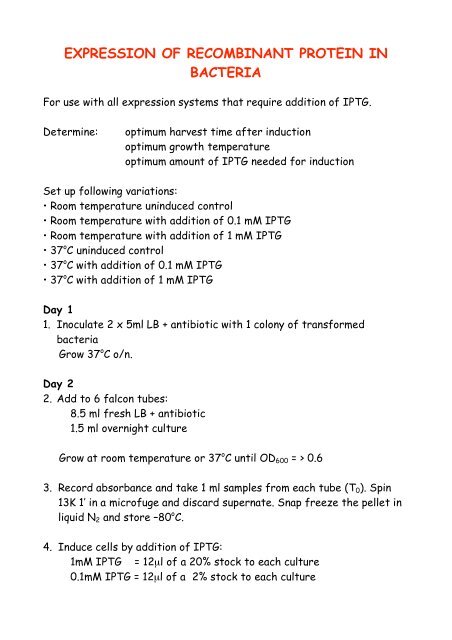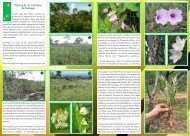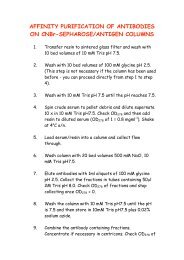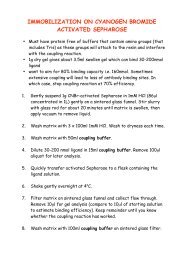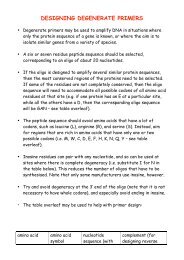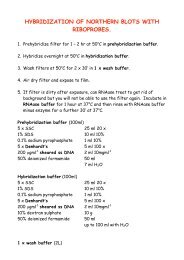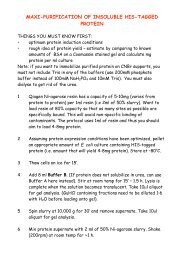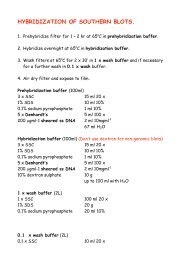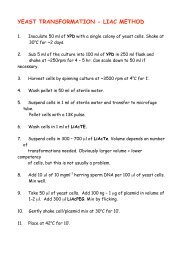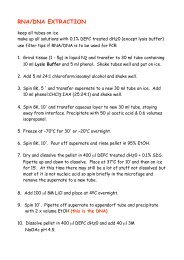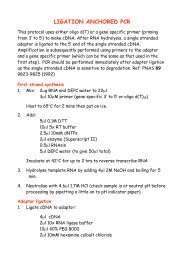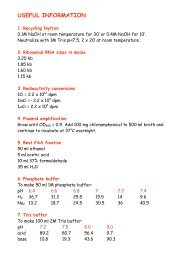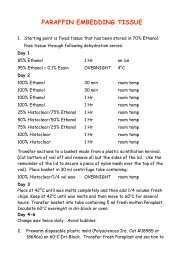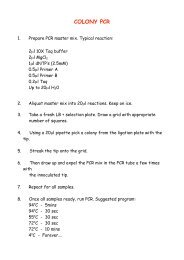Optimising expression of recombinant protein
Optimising expression of recombinant protein
Optimising expression of recombinant protein
Create successful ePaper yourself
Turn your PDF publications into a flip-book with our unique Google optimized e-Paper software.
EXPRESSION OF RECOMBINANT PROTEIN IN<br />
BACTERIA<br />
For use with all <strong>expression</strong> systems that require addition <strong>of</strong> IPTG.<br />
Determine:<br />
optimum harvest time after induction<br />
optimum growth temperature<br />
optimum amount <strong>of</strong> IPTG needed for induction<br />
Set up following variations:<br />
• Room temperature uninduced control<br />
• Room temperature with addition <strong>of</strong> 0.1 mM IPTG<br />
• Room temperature with addition <strong>of</strong> 1 mM IPTG<br />
• 37 o C uninduced control<br />
• 37 o C with addition <strong>of</strong> 0.1 mM IPTG<br />
• 37 o C with addition <strong>of</strong> 1 mM IPTG<br />
Day 1<br />
1. Inoculate 2 x 5ml LB + antibiotic with 1 colony <strong>of</strong> transformed<br />
bacteria<br />
Grow 37 o C o/n.<br />
Day 2<br />
2. Add to 6 falcon tubes:<br />
8.5 ml fresh LB + antibiotic<br />
1.5 ml overnight culture<br />
Grow at room temperature or 37 o C until OD 600 = > 0.6<br />
3. Record absorbance and take 1 ml samples from each tube (T 0 ). Spin<br />
13K 1’ in a micr<strong>of</strong>uge and discard supernate. Snap freeze the pellet in<br />
liquid N 2 and store –80 o C.<br />
4. Induce cells by addition <strong>of</strong> IPTG:<br />
1mM IPTG = 12µl <strong>of</strong> a 20% stock to each culture<br />
0.1mM IPTG = 12µl <strong>of</strong> a 2% stock to each culture
5. Take 1 ml samples from each tube at four different time points (T 1-4 ).<br />
Check OD 600 and then treat as described for T 0 . The absorbance<br />
readings will indicate if the cells are still dividing, stationary or dying.<br />
The optimum situation is one in which no cell growth or division is<br />
occurring so that the energy is going into production <strong>of</strong> the<br />
<strong>recombinant</strong> <strong>protein</strong>.<br />
Day 3<br />
6. Run acrylamide gel <strong>of</strong> time course to determine optimum conditions<br />
for<br />
<strong>protein</strong> production. Add 100 µl 1 x <strong>protein</strong> loading dye to each<br />
pellet,<br />
boil 5’ and load 10µl.<br />
1 X <strong>protein</strong> loading dye (20ml) (make fresh)<br />
1% SDS 2 ml 10%<br />
100 mM β-mercaptoethanol 138 µl<br />
0.1% bromophenol blue 2 ml 1%<br />
100 mM Tris pH 8.0 1 ml 2 M<br />
10% Ficoll 2 g


